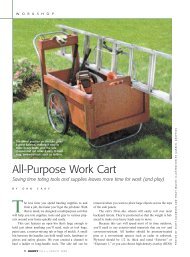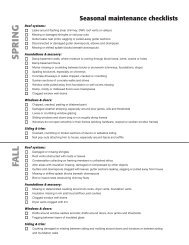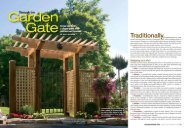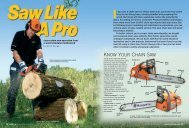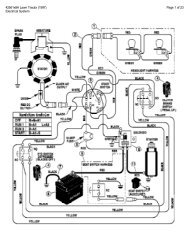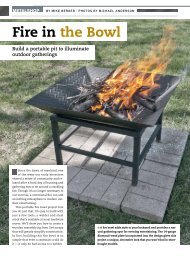Download this Stacked Stone Wall article as a pdf - Handyman Club ...
Download this Stacked Stone Wall article as a pdf - Handyman Club ...
Download this Stacked Stone Wall article as a pdf - Handyman Club ...
You also want an ePaper? Increase the reach of your titles
YUMPU automatically turns print PDFs into web optimized ePapers that Google loves.
Tools<br />
for the<br />
project<br />
In addition to shovels and levels, these are some essential<br />
hand tools for <strong>this</strong> type of project. Although<br />
none are motorized, most of them call for hearing<br />
protection, and all require protective eyewear.<br />
Hand<br />
guard<br />
Pick (pick mattock)<br />
This tool combines an ax<br />
head and a pick for chopping<br />
away at hard soil,<br />
roots and rocks before you<br />
shovel the soil out.<br />
Sledgehammer<br />
Its long handle and 10- to<br />
20-pound weight deliver<br />
great force for packing soil<br />
or gravel or pounding down<br />
a high spot in a stone.<br />
M<strong>as</strong>on’s hammer<br />
Also called a bricklayer’s<br />
hammer, <strong>this</strong> tool’s flat<br />
face and chisel-shape<br />
blade help to chip off<br />
edges of a stone.<br />
Wrecking bar<br />
It works <strong>as</strong> a lever to loosen<br />
and lift large boulders<br />
or adjust heavy stones, or<br />
you can use it <strong>as</strong> a pick to<br />
loosen hard soil.<br />
M<strong>as</strong>on’s chisel<br />
To score a cut line in<br />
stone, tap the top of a<br />
m<strong>as</strong>on’s chisel with a hammer;<br />
then deliver a heavy<br />
blow to split the stone.<br />
Setting stone<br />
As with any wall construction, the b<strong>as</strong>e<br />
course sets the stage for the rest of the<br />
project. For <strong>this</strong> first layer, you can use<br />
stones that have odd shapes or different<br />
thicknesses, <strong>as</strong> long <strong>as</strong> the top surfaces<br />
are all even and level. Just pound<br />
down any high spots using the top end<br />
of a maul (photo C, p. 24). Check for<br />
level front-to-back and side-to-side. (If<br />
you can’t get it perfect, err on the side<br />
of a slightly higher front edge than<br />
back.) Make each course level before<br />
you start the next layer — don’t plan to<br />
compensate for height differences later.<br />
As you install each stone, flip and turn<br />
it until you have a solid fit. You might<br />
need to try a different one for compatibility<br />
with neighboring stones and with<br />
the b<strong>as</strong>e. Set the front face of each new<br />
row 1/4 in. back from the previous row<br />
(photo D, p. 25).<br />
Natural stones’ irregular shapes<br />
sometimes make a slight “rocking”<br />
movement unavoidable. You can compensate<br />
by shimming with a stone chip<br />
(called chinking) under the offending<br />
rock (photo E). Where needed, you can<br />
knock off protruding edges of stones<br />
with a maul. Try to avoid leaving gaps<br />
between neighboring stones, but where<br />
they occur, fill vertical spaces with a<br />
stone chip and gravel (photo F).<br />
Use various sizes of levels to check<br />
each stone <strong>as</strong> you install it, adjusting for<br />
level front-to-back and side-to-side. Continue<br />
to backfill with gravel <strong>as</strong> you add<br />
each new course. Scott did not install<br />
landscape fabric because it tends to prevent<br />
drainage and to build hydrostatic Adding outcroppings<br />
pressure — especially in clay soil. If your To help support mounds of soil and<br />
soil is very sandy, you can add landscape plants within each tier, Scott placed<br />
fabric between the gravel backfill and the small boulders <strong>as</strong> outcroppings within<br />
soil behind it. Do not lay fabric directly the tiers (photo I). Strategically set to<br />
against the back of the wall.<br />
support the greatest elevation changes,<br />
For the top course (called capstones), these rocks are partially submerged in<br />
Scott used the thinner (2-in.) stones, the soil to help them stay in position.<br />
being careful to fit the shapes together (One of these boulders w<strong>as</strong> a lucky find:<br />
well (see “Cutting <strong>Stone</strong>,” p. 25). Once When excavating the patio area, Scott<br />
the entire top course w<strong>as</strong> in place, he discovered a large rock buried right in<br />
folded back the row of capstones and the spot where he had planned for one!)<br />
applied mortar (photo G, p. 26) before A small patio created along the sidewalk<br />
(photo J) provides room for potted<br />
pressing them in place. To prevent<br />
soil from seeping p<strong>as</strong>t the top layer of plants or a small sitting area. The flagstone<br />
floor w<strong>as</strong> laid over a 1-in.-thick<br />
stone, you can pack mortar along the<br />
back of the capstone row <strong>as</strong> well. ) b<strong>as</strong>e of compacted granite sand which,<br />
To allow room for a layer of soil and like the gravel used for b<strong>as</strong>e in the walls,<br />
plants, stop adding gravel backfill when is angular rather than rounded so it<br />
you’re 5 in. shy of the top of the wall. You locks together and stays in place. Once<br />
may choose to place landscape fabric on the 1-1/2- to 2-in.-thick flagstones were<br />
top of the gravel before adding the soil. in place, gaps between them were filled<br />
with more granite sand.<br />
Building up<br />
The upper walls are constructed like<br />
the first: Dig a trench, pack in a 4-in.-<br />
thick gravel b<strong>as</strong>e and install level<br />
courses of stone with 8 to 10 in. of<br />
gravel backfill behind. Dig the trench<br />
deep enough that the top of the b<strong>as</strong>e<br />
course is level with (or slightly lower<br />
than) the capstone of the lower wall.<br />
The return walls (the sections that Get the free Proper mobile app at<br />
Planting<br />
run alongside the steps and into the hill) http:/ / gettag.mobi<br />
To see a planting<br />
need to extend into the soil at le<strong>as</strong>t 6 in.<br />
secret from<br />
m<strong>as</strong>ter gardener<br />
beyond their exposed portions (photo H).<br />
Amy Sitze, scan<br />
The hidden portions must also be supported<br />
with packed gravel and a course<br />
com/magazine.<br />
<strong>this</strong> tag to or visit<br />
<strong>Handyman</strong><strong>Club</strong>.<br />
of b<strong>as</strong>e stone.<br />
28<br />
APRIL/MAY 2013



